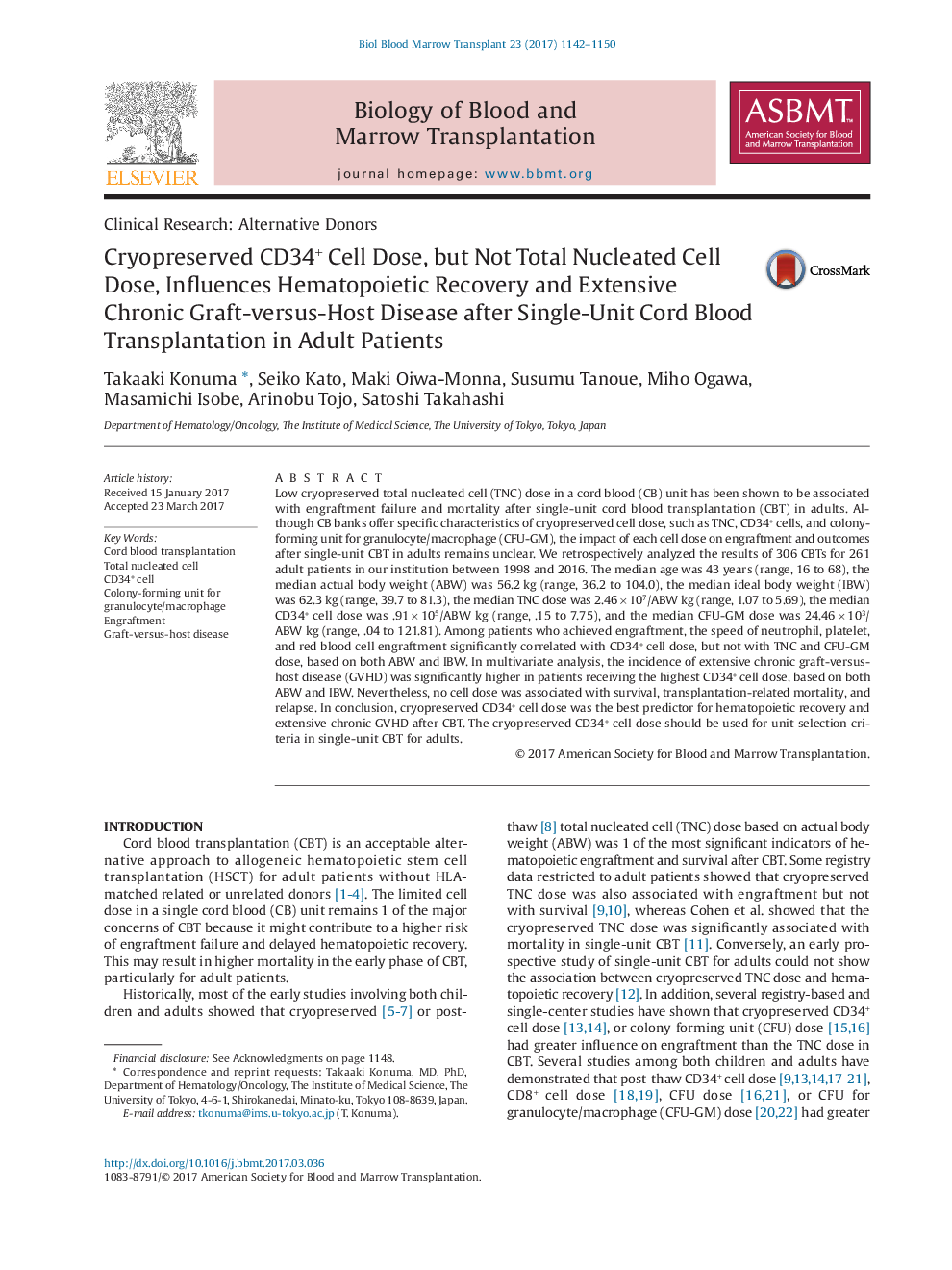| کد مقاله | کد نشریه | سال انتشار | مقاله انگلیسی | نسخه تمام متن |
|---|---|---|---|---|
| 5524351 | 1546239 | 2017 | 9 صفحه PDF | دانلود رایگان |

- We retrospectively investigated the characteristics of cryopreserved cell dose, such as total nucleated cells, CD34+ cells, and colony-forming unit for granulocyte/macrophage, based on actual or ideal body weight associated with engraftment and outcomes after single-unit cord blood transplantation for adult patients
- The speed of neutrophil, platelet, and red blood cell engraftment significantly correlated with CD34+ cell dose, but not with total nucleated cells and colony-forming unit for granulocyte/macrophage dose, based on both actual and ideal body weight among patients who achieved engraftment
- The cumulative incidence of extensive chronic graft-versus-host disease was significantly higher in patients receiving the highest CD34+ cell dose (â¥1.5âÃâ105/kg).
- Total nucleated cells, CD34+ cell, and colony-forming unit for granulocyte/macrophage doses were not associated with survival, transplantation-related mortality, and relapse
- CD34+ cell dose was the best predictor for hematopoietic recovery and extensive chronic graft-versus-host disease after cord blood transplantation
Low cryopreserved total nucleated cell (TNC) dose in a cord blood (CB) unit has been shown to be associated with engraftment failure and mortality after single-unit cord blood transplantation (CBT) in adults. Although CB banks offer specific characteristics of cryopreserved cell dose, such as TNC, CD34+ cells, and colony-forming unit for granulocyte/macrophage (CFU-GM), the impact of each cell dose on engraftment and outcomes after single-unit CBT in adults remains unclear. We retrospectively analyzed the results of 306 CBTs for 261 adult patients in our institution between 1998 and 2016. The median age was 43 years (range, 16 to 68), the median actual body weight (ABW) was 56.2âkg (range, 36.2 to 104.0), the median ideal body weight (IBW) was 62.3âkg (range, 39.7 to 81.3), the median TNC dose was 2.46âÃâ107/ABW kg (range, 1.07 to 5.69), the median CD34+ cell dose was .91âÃâ105/ABW kg (range, .15 to 7.75), and the median CFU-GM dose was 24.46âÃâ103/ABW kg (range, .04 to 121.81). Among patients who achieved engraftment, the speed of neutrophil, platelet, and red blood cell engraftment significantly correlated with CD34+ cell dose, but not with TNC and CFU-GM dose, based on both ABW and IBW. In multivariate analysis, the incidence of extensive chronic graft-versus-host disease (GVHD) was significantly higher in patients receiving the highest CD34+ cell dose, based on both ABW and IBW. Nevertheless, no cell dose was associated with survival, transplantation-related mortality, and relapse. In conclusion, cryopreserved CD34+ cell dose was the best predictor for hematopoietic recovery and extensive chronic GVHD after CBT. The cryopreserved CD34+ cell dose should be used for unit selection criteria in single-unit CBT for adults.
Journal: Biology of Blood and Marrow Transplantation - Volume 23, Issue 7, July 2017, Pages 1142-1150